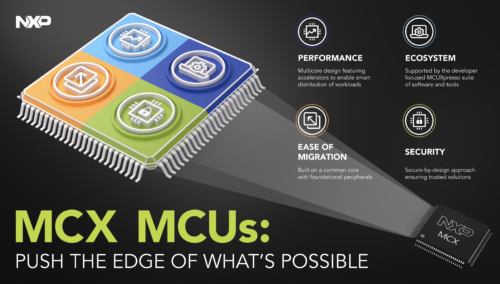Low power, low cost, high performance, wireless connectivity? MCX has a family for that!
The adoption of 32-bit microcontrollers (MCUs) in a market previously dominated by 8- and 16-bit devices has surged over the past two decades. The market size of 32-bit MCUs surpassed that of either 8- or 16-bit products a decade ago, and sales of 32-bit devices continue to grow strongly compared to those lower-performance devices. The reasons are clear: there are many applications that call for the increases in memory capacity and processing speed that 32bit architectures such as the Arm® Cortex® -M family continue to deliver.
Connectivity has become a key element of many product designs so that, in addition to reporting report their status and receive commands remotely, they form part of a larger system of systems in which multiple devices on the internet of things (IoT) collaborate to enable sophisticated applications. That not only drives demand for integrated wireless communications capability, but also for a security framework that ensures devices cannot be compromised by remote attacks or by malicious users.
Built-in performance is also crucial. The arrival of commercially successful artificial intelligence (AI) and machine learning (ML) in the server space is now driving the evolution of the same technologies at the edge. Consumers and industrial users alike want the rapid response that is possible only with local intelligence. That means not having to rely on large quantities of data being relayed to the cloud, especially if the embedded devices have access only to unreliable or low-bandwidth connections. Privacy concerns have also emerged in recent years, providing another reason for performing ML functions locally to avoid potentially sensitive data being transmitted over the internet. An on-chip secure subsystem provides the necessary protection for a secure boot, preventing malicious code from hijacking the system.
Although they need more features and performance, when migrating to a new platform, longstanding users of MCUs such as those from NXP’s large LPC and Kinetis families do not want to lose the experience amassed over many years of using these devices. These considerations drove the specification of not just the MCX series of MCUs, but also the software and supply-chain infrastructure around them.
In designing the MCX hardware, NXP set out to build a series of devices that can handle the huge range of demands that now feature in the 32-bit MCU space. As its starting point, NXP took the powerful but efficient Cortex-M33 core. Around this core are peripherals that are tuned for each target application and market space. The products range from low-power devices in the MCX L series and low-cost MCUs in the MCX A series, up to the advanced features of the MCX N series with as much as 4MB of onboard flash and 1MB of SRAM. Another example of this internal differentiation lies in the security features that each family offers.
Designed for high-performance embedded systems, the MCX N Series features the EdgeLock(R) Secure Subsystem that provides a root-of-trust implementation in silicon. The hardware includes cryptographic acceleration engines protected against side-channel attacks that are increasingly being used against MCU based products to obtain access to the private keys held in the system.
Only code blocks that carry the correct cryptographic signature will be loaded and made ready for execution. This ensures that even if an attacker finds a way to load a compromised binary either over the network or using local memory access into flash—the MCU will reject this binary and fall back to an authentic version of the boot code if it is available.
Similarly, the MCX A series, which is optimized for real-time applications such as motor control, offers essential security features. These include the ability to control on-chip memory access and product life cycle control, supporting options for field upgrade and control over the debug port.
Backing all this up is a supply-chain initiative that not only ensures security credentials are specific to each manufactured device, but which can be used to protect OEMs against threats such as overbuilding by contract manufacturers. For the MCX portfolio, NXP provides support for key management and device attestation, making it easier for OEMs to build IoT systems that can automatically connect to application servers and prove their authenticity. The implementation of these pre-configured security and key management policies enables device makers to simplify the path to certification, avoid costly mistakes, and save development time.
As MCX represents the follow-on architecture to the existing LPC and Kinetis portfolios of Arm Cortex-based MCUs, a key attribute of the new portfolio is the continued use of a unified development environment that lets developers carry their engineering investment in those earlier families into successive designs.
Both the LPC and Kinetis were distinguished by their rich portfolios of peripherals. Many of these peripherals are carried through into MCX, allowing embedded developers to leverage their experience in using them in their new projects. In addition, the extension of the two legacy families into the next generation MCX allows customers to access a wider range of peripherals. Both migration and fresh development for device-level code are supported by the continuation of the MCUXpresso suite of software and tools, which combines development and configuration tools with firmware and middleware that eases the job of porting embedded software.
MCUXpresso provides options to use leading integrated development environments (IDEs) from IAR and Arm, or NXP’s free IDE based on the open-source Eclipse codebase and highly customized for its MCU families. SDK builder tools and configuration tools enable customers to quickly select software options and configure pins, clocks, and drivers for their own custom boards, generating initialization C code and register settings so that they can move to working firmware as quickly as possible. On top of this, middleware is provided by NXP and its broad network of partners to support the complex application environments that many designs now need, such as support for wireless communications through the Bluetooth Low Energy (BLE) interface built into the MCX W family devices and others.
The software support extends to the eIQ environment for ML development. Developers can utilize the easy-to-use tools offered by eIQ to train ML models that can run on the core M33 processor or, in the case of the MCX N series, take advantage of a built-in neural processing unit (NPU). Designed by NXP, the NPU is optimized for performing the inference computations needed to run high-performance local ML models and can deliver 30 times the throughput of code compiled for the M33. This additional ML performance makes possible AI functions that would otherwise need to be offloaded to cloud servers and incur the cost and latency that those data transfers would entail.
If applications call for even more performance, the extension of MCUXpresso and eIQ support to the i.MX RT crossover MCUs provides developers with an easy and effective migration path. With the MCX series now joining the NXP offering of embedded microcontroller solutions, developers have an easy way of migrating to the latest features and continue to innovate in response to market demands.

